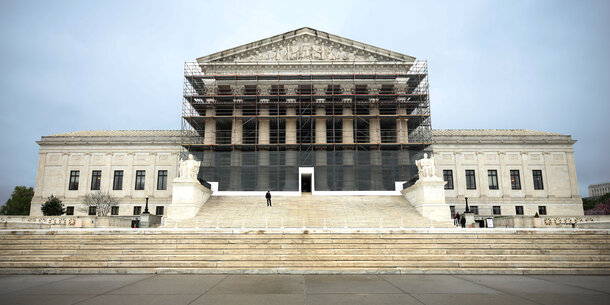The Supreme Court’s so-called shadow docket for emergency motions has played an outsized role in legal challenges against the new Trump administration. On issues ranging from dismantling the Department of Education to banning transgender people from serving in the military, federal trial judges from across the ideological spectrum have repeatedly blocked actions by the administration, only for the Supreme Court to halt those rulings with little or no explanation.
While the administration has only sought emergency review in some cases, its overall use of the shadow docket has skyrocketed. In the first 20 weeks of Trump’s second term, the administration sought emergency action by the Court 19 times — the same number of requests made by the Biden administration over four years, according to Georgetown law professor Steve Vladeck. And the Court has sided with the administration nearly every time.
There’s much to critique in the Court’s approach to the shadow docket, but one of the most troubling features has been how often the Court has allowed administration policies to move forward without any explanation at all, after lower courts had issued preliminary rulings indicating that the policies were likely illegal or unconstitutional.
To date, the Court has sided with the administration without offering any analysis in seven cases — including major rulings that allowed the administration to strip temporary legal status from hundreds of thousands of immigrants and summarily deport migrants to countries where they have no connection, including war zones. Most other shadow docket rulings include only cursory analysis.
Supreme Court Shadow Docket Tracker >>
Justice Brett Kavanaugh recently defended the Court’s use of unexplained emergency orders in these cases. In remarks during a judges’ conference, he spoke about the risk of “a lock-in effect” when the Court makes “a snap judgment and put[s] it in writing.” Because the shadow docket isn’t the Court’s final word on the legal issues in a case, Kavanaugh warned that a written opinion may not reflect the Court’s ultimate view.
It’s illuminating to get this glimpse into the Court’s shadow docket thinking — ironically, with more analysis than what appears in many shadow docket rulings themselves. But Kavanaugh’s defense of secretive decision-making doesn’t hold water.
To begin with, while a shadow docket decision doesn’t conclusively resolve the legal issues in a case, as a practical matter it often does serve as the final word. Once agencies are gutted, migrants deported, and major policies implemented, it is often not possible to ever unring the bell and return to the prior status quo. That’s why our system gives lower courts the power to order preliminary injunctions in the first place.
Supreme Court decisions halting such orders have profound implications for both the plaintiffs and broader American society. To do so without any explanation is an abdication of the Court’s responsibility to interpret and apply the law.
Justice Elena Kagan put it plainly in her own recent remarks about the shadow docket: “Courts are supposed to explain things.” Offering reasons for judicial decisions is an essential protection against arbitrary power — to ensure that like cases are being treated alike. The practice imposes discipline on justices’ decision-making processes and allows the public to evaluate whether the Supreme Court’s justifications are valid. And it is especially important when the Court is making snap judgments that are prone to error and bias.
The Court’s recent shadow docket rulings highlight that there is in fact much to question about its unstated justifications. As several commentators have noted, it is hard to square many of the Court’s shadow docket decisions with the legal standards it is supposed to be applying. For example, the test for whether to halt a lower court injunction includes evaluating whether the applicant — in these cases, the Trump administration — risks irreparable harm if the injunction stays in place and whether the equities and public interest are on its side. In case after case, dissenting justices have argued that the Court has “botched” this analysis and made rulings that are “as incomprehensible as [they are] inexcusable,” halting lower court injunctions without any showing that the government is facing harm and with grave consequences, including in some cases in which the plaintiffs are at risk of torture or death. The majority’s response to these serious claims? Silence.
The Court’s failure to explain its rulings has also opened the door to the Trump administration embracing a maximalist interpretation of what the Court has authorized. For example, in the case challenging mass firings in the Department of Education, the principal arguments raised by the government were procedural — that the plaintiffs lacked standing to bring their case. Yet after the Court allowed the firings to go forward, Secretary of Education Linda McMahon issued a statement touting that the Court had “confirmed” the president’s broad powers. The odds are that the justices’ reasoning didn’t turn on the president’s powers at all, but it’s hard to call McMahon’s statement a mischaracterization when there was no analysis to characterize in the first place.
Nor does Kavanaugh’s concern about being locked into a decision prematurely stand up to scrutiny. When the Court considers a case on its shadow docket, it applies a different and far more tentative legal standard than when ruling on the ultimate legal merits in a case. Among a number of factors, the Court considers whether there is a “fair prospect” it will eventually overrule the lower court, a standard that on its own terms makes clear that the Court’s analysis about the ultimate merits is speculative and subject to change.
The United States is at a precarious moment of democratic backsliding. The courts are being asked to serve as a check on abuses of presidential power and a backstop for the rule of law. In case after case, the Supreme Court has declined that charge. It owes the public an explanation as to why.



